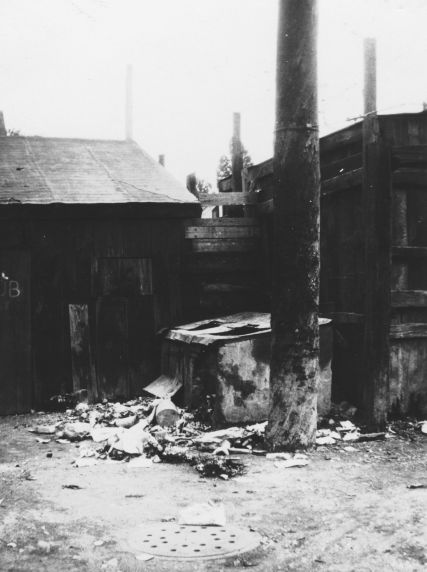Detroit's Black Bottom and Paradise Valley Neighborhoods
- African Americans
- African Americans--Michigan--Detroit--Social conditions--20th century
- Detroit (Mich.)
- Detroit--race relations
- Discrimination in housing--Michigan
- Housing
- Housing development--Michigan--Detroit
- Interstate 75
- Reuther, Victor G., 1912
- Reuther, Walter, 1907-1970
- Student Blogger Series
- Urban Affairs
- Urban renewal
In the Winter 2012 semester, the Reuther Library worked with students in the Graduate Certificate in Archival Administration program at the Wayne State School of Library and Information Science to produce a series of student-written, guest blog posts.
Cathy MacDonald is a student in the Archival Administration Program at Wayne State University. She is currently interning at the Arab American National Museum’s Library and Resource Center.
Detroit’s Black Bottom and Paradise Valley neighborhoods provided both housing and entertainment for the city’s African American community from the 1920s through the 1940s. African Americans, refused entrance to most white neighborhoods, crowded into the Black Bottom area where rent was higher and the housing poorer. Paradise Valley, meanwhile, consisted primarily of black-owned businesses where African Americans could shop, eat and relax. These areas stretched between the Detroit River on the south and Grand Boulevard on the north, roughly along where I-75 is currently. Black Bottom, the poorest section, stretched south from Gratiot to the River, and Paradise Valley extended north of Gratiot, as far as Grand Boulevard, though it was more concentrated near Gratiot. Most of the area’s inhabitants had migrated north to work in Detroit’s factories where they could make considerably more money than they could working in southern states.
Paradise Valley became the place to go for a night on the town. The nightclubs, restaurants and stores attracted whites as well as blacks encouraging racial integration more than any other part of the city at that time. As Elaine Moon wrote in her article “Paradise Valley,” “It was the black downtown, Broadway, Las Vegas. A place of fun, brotherhood, and games of chance. A place known from here to Europe. In the 1930’s and early 40’s in Detroit a night on the town, for Black or White, was not complete without a stop at Paradise Valley. It was here that integration began – where Black and White first sat side by side for eating and entertainment. It was here that many politicians got their start – sowing seeds in Black Bottom. It was here that ball players found a haven when they were ostracized from white hotels and restaurants" (Moon, p. 15).
By the 1940s, the huge influx of people arriving in Detroit to work in the factories following World War II caused a housing crisis. The city did not have enough living space and the issue of racism only compounded the problem. While the entire city of Detroit struggled with lack of adequate housing, Black Bottom contained the poorest living quarters. Many of the inhabitants found themselves squeezed into a single room with no cooking facilities or indoor plumbing. Although this arrangement helped form a tight-knit community, the unsanitary conditions were deplorable. Unfortunately, rather than try to improve the housing situation, the city saw the poor conditions as an excuse to raze the area. Also, when seeking space for a new expressway system, city planners selected this neighborhood as the thoroughfare for the new I-75.
Detroit’s urban renewal project targeted blighted areas for razing and reconstruction. As noted by Thomas Sugrue in his book The Origins of the Urban Crisis: Race and Inequality in Postwar Detroit, “City officials expected that the eradication of ‘blight’ would increase city tax revenue, revitalize the decaying urban core, and improve the living conditions of the poorest slum dwellers. Overcrowded, unsanitary, and dilapidated districts like Paradise Valley and the Lower East Side would be replaced by clean, modern, high-rise housing projects, civic institutions and hospitals” (p. 48). The destruction of this neighborhood with little warning or effort on the part of the city to provide housing assistance was catastrophic for the African American community in Detroit. “In 1958, the Wayne County road commissioner predicted that little difficulty will be experienced by families facing displacement because of highway construction, even though the families on highway sites received only a thirty-day notice to vacate and the commission made no efforts to assist families in relocation" (Sugrue, p. 48).
A view of the construction of I-75, the Chrysler Freeway, in the area that had once been Paradise Valley
I-75, Ford Field, and Comerica Park now occupy most of the area where Paradise Valley once stood. As for the families displaced by the razing of the Paradise Valley neighborhood, “about one-third of the Gratiot area’s families eventually moved to public housing, but 35 percent of the families in the area could not be traced. The best-informed city officials believed that a majority of families moved to neighborhoods within a mile of the Gratiot site, crowding into an already decaying part of the city, and finding houses scarcely better and often more overcrowded than that which they had left” (Sugrue, p. 10).
The Walter P. Reuther Library contains several items related to the Paradise Valley and Black Bottom neighborhoods including the book The Origins of the Urban Crisis by Thomas J. Sugrue, the Detroit – History vertical file, the Walter and Victor Reuther scrapbook in the AV collections, the Carl Almblad Papers containing documents regarding Detroit’s urban renewal project, and oral histories on Black Bottom contained in the Untold Tales, Unsung Heroes Oral Histories collection. For more on urban renewal in the 1960s, see the Jerome P. Cavanagh Papers and the Detroit Commission on Community Relations (DCCR) / Human Rights Department Records.
References
Moon, Elaine “(The Past Prologue): Paradise Valley” Detroit History Vertical File, Walter P.
Reuther Library, Wayne State University.
Thomas J. Sugrue, Origins of the Urban Crisis, (Princeton, NJ: Princeton University Press, 1996).
Wendy Doniger, Splitting the Difference, (Chicago: University of Chicago Press, 1999).
- Public Relations Team's blog
- Login to post comments
- Printer-friendly version



 Reddit
Reddit Facebook
Facebook LinkedIn
LinkedIn